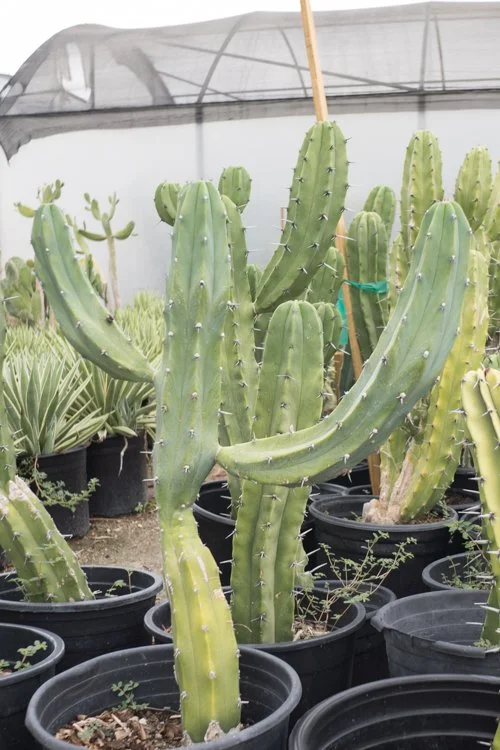Blue Myrtle Cactus
Blue myrtle cactus is a fun plant to observe.
It grows moderately fast and takes on different forms as it matures.
When young, its single stem grows straight up. Then, it will branch out to sport a fun, candelabra-like appearance, eventually becoming a giant shrub with numerous branches. Finally, once very mature, it will grow a central trunk to form a spectacular cactus tree.
One other rewarding aspect of keeping a Blue myrtle cactus is its fruits. Called "garambullos" by Mexicans and Guatemalans, these sweet fruits are also consumed by different Native American populations.
Botanical name: Myrtillocactus Geometrizans
Other names: Bilberry cactus, Blue candle cactus, Cereus geometrizans, Garambullo
Close up look at Blue myrtle cactus
TABLE OF CONTENTS
Blue Myrtle Cactus Appearance
The blue myrtle cactus is a columnar cactus that got its nickname for its color and form.
The stems are bluish-green to deep green in color.
When young, the cactus grows vertically as a single stem, eventually branching out profusely to create a shrubby appearance. When very mature, the Blue myrtle cactus will develop a single trunk to form a tree.
Can grow to 10-15 feet tall and twice as wide.
Thick stems with 5-9 ribs and sharp spines. The ribs form an interesting geometric pattern, hence the word "geometrizes" in its botanical name.
The smooth, waxy surface below the spines. The bumps and waxy surface help to save moisture within the plant.
Large and showy cream-colored flowers when in bloom.
Followed by edible, dark, oval-shaped fruits called "garambullos" in Spanish.
Blue Myrtle Cactus Landscaping Tips
Blue myrtle cactus for sale at the nursery
Unless planted in a container, allow for ample vertical and horizontal space for the Blue myrtle cactus to grow.
Blue myrtle cactus grows moderately fast at about half a foot to one foot a year.
Works well among other desert plants in drought-tolerant gardens.
Has a striking and formidable appearance once mature.
The edible fruits are sweet and are consumed regularly by Native Americans, Mexicans, and Guatemalans.
Blue Myrtle Cactus Origin
Blue myrtle cactus is native to warm and dry regions of Mexico.
Blue Myrtle Cactus Care
Soil: Loose, well-draining soil that is moderately fertile. Cactus or succulent soil mixes work well.
Temperature: Can withstand temperatures down to 25 degrees for a brief period of time.
Water: Occasional, deep watering. Allow the soil to completely dry out between waterings. Either use a moisture meter or stick your finger through the soil to gauge the moisture level. It’s better to err on the side of underwatering than overwatering.
Sun: Full sun. Partial shade ok in the Palm Springs region.
Blue Myrtle Cactus Problems
Pests: Blue myrtle cactus has minimal pests. Fungal diseases from root rot, dry rot, and harsh weather conditions.
Signs of overwatering: Drooping, squishy texture (especially at the bottom of the cactus)
Signs of too little water: Shriveling, drying skin, fading color
Signs of too much sun: Burning, scarring
Signs of too little sun: Etiolation, discoloring
Blue Myrtle Cactus Propagation
Take stem cuttings to propagate your Blue myrtle cactus. Using a blade, cut the very top part of the plant, allow it to callous, and plant it into the soil.
Once mature, the cactus will grow fruit. You can take the seeds and directly plant them.
FAQ
How much does Blue Myrtle cactus cost?
At our nursery, Blue myrtle cactus costs $15 for a 1-gallon container, $45 for a 5-gallon container, and $120 for a 15-gallon container.
Prices are subject to change. Please contact us for the most up-to-date information on pricing. We may have larger sizes available. We provide installation services locally at a separate cost.
How big does Blue Myrtle Cactus get?
Blue myrtle cactus can grow to 10-15 feet tall and twice as wide.
How fast does Blue Myrtle Cactus grow?
In the Palm Springs area, you can expect it to grow half a foot to one foot a year until it reaches maturity.
Summary
| SIZE (H X W) | 10-15 feet X 20 feet |
|---|---|
| FLOWER COLOR | White |
| FLOWER SEASON | Spring |
| EXPOSURE | Full Sun to Partial Shade |
| WATER | Low |
| GROWTH RATE | Moderate |
| HARDINESS | 25º F, USDA Zone 9 |
| PRUNING | None |

